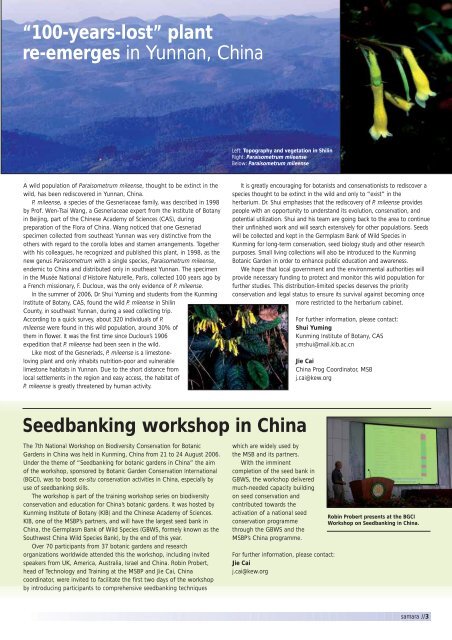MSBP Regional Workshop in Botswana - Royal Botanic Gardens, Kew
MSBP Regional Workshop in Botswana - Royal Botanic Gardens, Kew
MSBP Regional Workshop in Botswana - Royal Botanic Gardens, Kew
Create successful ePaper yourself
Turn your PDF publications into a flip-book with our unique Google optimized e-Paper software.
“100-years-lost” plant<br />
re-emerges <strong>in</strong> Yunnan, Ch<strong>in</strong>a<br />
Left: Topography and vegetation <strong>in</strong> Shil<strong>in</strong><br />
Right: Paraisometrum mileense<br />
Below: Paraisometrum mileense<br />
A wild population of Paraisometrum mileense, thought to be ext<strong>in</strong>ct <strong>in</strong> the<br />
wild, has been rediscovered <strong>in</strong> Yunnan, Ch<strong>in</strong>a.<br />
P. mileense, a species of the Gesneriaceae family, was described <strong>in</strong> 1998<br />
by Prof. Wen-Tsai Wang, a Gesneriaceae expert from the Institute of Botany<br />
<strong>in</strong> Beij<strong>in</strong>g, part of the Ch<strong>in</strong>ese Academy of Sciences (CAS), dur<strong>in</strong>g<br />
preparation of the Flora of Ch<strong>in</strong>a. Wang noticed that one Gesneriad<br />
specimen collected from southeast Yunnan was very dist<strong>in</strong>ctive from the<br />
others with regard to the corolla lobes and stamen arrangements. Together<br />
with his colleagues, he recognized and published this plant, <strong>in</strong> 1998, as the<br />
new genus Paraisometrum with a s<strong>in</strong>gle species, Paraisometrum mileense,<br />
endemic to Ch<strong>in</strong>a and distributed only <strong>in</strong> southeast Yunnan. The specimen<br />
<strong>in</strong> the Musée National d’Histoire Naturelle, Paris, collected 100 years ago by<br />
a French missionary, F. Ducloux, was the only evidence of P. mileense.<br />
In the summer of 2006, Dr Shui Yum<strong>in</strong>g and students from the Kunm<strong>in</strong>g<br />
Institute of Botany, CAS, found the wild P. mileense <strong>in</strong> Shil<strong>in</strong><br />
County, <strong>in</strong> southeast Yunnan, dur<strong>in</strong>g a seed collect<strong>in</strong>g trip.<br />
Accord<strong>in</strong>g to a quick survey, about 320 <strong>in</strong>dividuals of P.<br />
mileense were found <strong>in</strong> this wild population, around 30% of<br />
them <strong>in</strong> flower. It was the first time s<strong>in</strong>ce Ducloux’s 1906<br />
expedition that P. mileense had been seen <strong>in</strong> the wild.<br />
Like most of the Gesneriads, P. mileense is a limestonelov<strong>in</strong>g<br />
plant and only <strong>in</strong>habits nutrition-poor and vulnerable<br />
limestone habitats <strong>in</strong> Yunnan. Due to the short distance from<br />
local settlements <strong>in</strong> the region and easy access, the habitat of<br />
P. mileense is greatly threatened by human activity.<br />
It is greatly encourag<strong>in</strong>g for botanists and conservationists to rediscover a<br />
species thought to be ext<strong>in</strong>ct <strong>in</strong> the wild and only to “exist” <strong>in</strong> the<br />
herbarium. Dr. Shui emphasises that the rediscovery of P. mileense provides<br />
people with an opportunity to understand its evolution, conservation, and<br />
potential utilization. Shui and his team are go<strong>in</strong>g back to the area to cont<strong>in</strong>ue<br />
their unf<strong>in</strong>ished work and will search extensively for other populations. Seeds<br />
will be collected and kept <strong>in</strong> the Germplasm Bank of Wild Species <strong>in</strong><br />
Kunm<strong>in</strong>g for long-term conservation, seed biology study and other research<br />
purposes. Small liv<strong>in</strong>g collections will also be <strong>in</strong>troduced to the Kunm<strong>in</strong>g<br />
<strong>Botanic</strong> Garden <strong>in</strong> order to enhance public education and awareness.<br />
We hope that local government and the environmental authorities will<br />
provide necessary fund<strong>in</strong>g to protect and monitor this wild population for<br />
further studies. This distribution-limited species deserves the priority<br />
conservation and legal status to ensure its survival aga<strong>in</strong>st becom<strong>in</strong>g once<br />
more restricted to the herbarium cab<strong>in</strong>et.<br />
For further <strong>in</strong>formation, please contact:<br />
Shui Yum<strong>in</strong>g<br />
Kunm<strong>in</strong>g Institute of Botany, CAS<br />
ymshui@mail.kib.ac.cn<br />
Jie Cai<br />
Ch<strong>in</strong>a Prog Coord<strong>in</strong>ator, MSB<br />
j.cai@kew.org<br />
Seedbank<strong>in</strong>g workshop <strong>in</strong> Ch<strong>in</strong>a<br />
The 7th National <strong>Workshop</strong> on Biodiversity Conservation for <strong>Botanic</strong><br />
<strong>Gardens</strong> <strong>in</strong> Ch<strong>in</strong>a was held <strong>in</strong> Kunm<strong>in</strong>g, Ch<strong>in</strong>a from 21 to 24 August 2006.<br />
Under the theme of “Seedbank<strong>in</strong>g for botanic gardens <strong>in</strong> Ch<strong>in</strong>a” the aim<br />
of the workshop, sponsored by <strong>Botanic</strong> Garden Conservation International<br />
(BGCI), was to boost ex-situ conservation activities <strong>in</strong> Ch<strong>in</strong>a, especially by<br />
use of seedbank<strong>in</strong>g skills.<br />
The workshop is part of the tra<strong>in</strong><strong>in</strong>g workshop series on biodiversity<br />
conservation and education for Ch<strong>in</strong>a’s botanic gardens. It was hosted by<br />
Kunm<strong>in</strong>g Institute of Botany (KIB) and the Ch<strong>in</strong>ese Academy of Sciences.<br />
KIB, one of the <strong>MSBP</strong>’s partners, and will have the largest seed bank <strong>in</strong><br />
Ch<strong>in</strong>a, the Germplasm Bank of Wild Species (GBWS, formely known as the<br />
Southwest Ch<strong>in</strong>a Wild Species Bank), by the end of this year.<br />
Over 70 participants from 37 botanic gardens and research<br />
organizations worldwide attended this the workshop, <strong>in</strong>clud<strong>in</strong>g <strong>in</strong>vited<br />
speakers from UK, America, Australia, Israel and Ch<strong>in</strong>a. Rob<strong>in</strong> Probert,<br />
head of Technology and Tra<strong>in</strong><strong>in</strong>g at the <strong>MSBP</strong> and Jie Cai, Ch<strong>in</strong>a<br />
coord<strong>in</strong>ator, were <strong>in</strong>vited to facilitate the first two days of the workshop<br />
by <strong>in</strong>troduc<strong>in</strong>g participants to comprehensive seedbank<strong>in</strong>g techniques<br />
which are widely used by<br />
the MSB and its partners.<br />
With the imm<strong>in</strong>ent<br />
completion of the seed bank <strong>in</strong><br />
GBWS, the workshop delivered<br />
much-needed capacity build<strong>in</strong>g<br />
on seed conservation and<br />
contributed towards the<br />
activation of a national seed<br />
conservation programme<br />
through the GBWS and the<br />
<strong>MSBP</strong>’s Ch<strong>in</strong>a programme.<br />
For further <strong>in</strong>formation, please contact:<br />
Jie Cai<br />
j.cai@kew.org<br />
Rob<strong>in</strong> Probert presents at the BGCI<br />
<strong>Workshop</strong> on Seedbank<strong>in</strong>g <strong>in</strong> Ch<strong>in</strong>a.<br />
samara //3
















